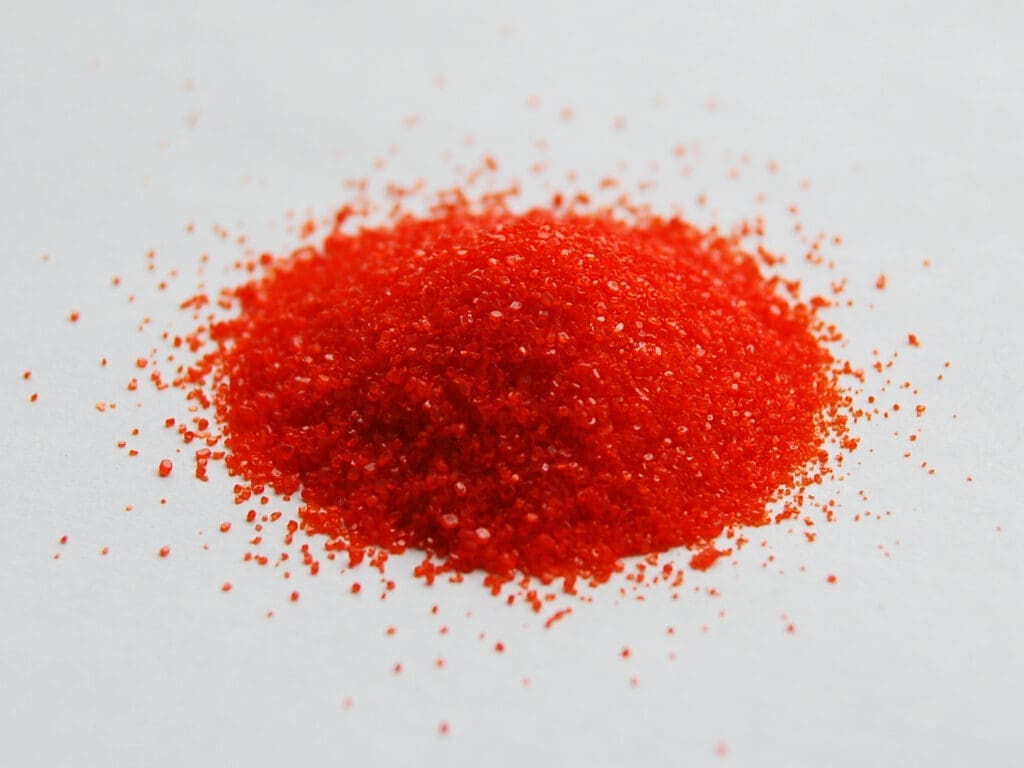
Kalium bichromicum
Latin name: Kalium bichromicum
Short name: kali-bi
Common name: Bichromate of Potash | Potassium bichromate | Potassium dichromate | Chrome red | Dichromate of potassium
Primary miasm: Syphilitic Secondary miasm(s): Sycotic
Kingdom: Minerals
Family: Inorganic compound
- Symptomatology
- Remedy Information
- Differentiation & Application
Kali bichromicum is a chemical compound composed of potassium (K) and bichromate (Cr₂O₇) ions. Its chemical formula is K₂Cr₂O₇. It is an orange-red crystalline salt that is highly toxic and corrosive in crude form. In homeopathy, it is rendered harmless through trituration and serial dilution, unlocking its dynamic curative potential.
Outside of homeopathy, potassium bichromate has been used as an oxidising agent in laboratories, for etching and dyeing in textiles and leather processing, and in photography. Due to its toxic and carcinogenic properties, its industrial use is now restricted under safety regulations.
First proved by Dr. Samuel Swan (USA), and later elaborated upon by Hering and others in the mid-19th century. The proving was conducted with trituration and ingestion, and symptoms were well-documented in Hering’s Guiding Symptoms and Allen’s Encyclopaedia.
Kali bichromicum has a powerful and peculiar affinity for the mucous membranes, particularly of the nose, throat, sinuses, stomach, and intestines. It also targets the joints, bones, and fibrous tissues, leading to ulcerations, thickened secretions, and wandering rheumatic pains. It shows strong action on the respiratory tract, producing tough, tenacious mucus that is stringy and yellow. The gastric system is notably affected, with vomiting, heaviness, and ulcers. Skin manifestations tend toward ulceration, especially with defined, punched-out edges. The remedy also acts upon the periosteum, liver, and the eyes.
- Warmth, particularly of bed or applied locally
- Motion, in some rheumatic complaints
- Pressure (in some head and abdominal pains)
- Short naps
- In open air (certain head symptoms)
- Cold, damp weather
- Morning (especially 2–3 AM and after rising)
- Beer and alcohol
- Suppressed catarrhal discharges
- Hot weather for skin symptoms
- Undue exertion
- Eating, especially rich or sour food
- Mercurius – Also offensive discharges and ulcerations, but with more salivation and bone pain.
- Nitric acid – Similar deep ulcers, but more splinter-like pains and emotional irritability.
- Silicea – Skin and sinus complaints, but more chilly, with pus and poor healing.
- Lachesis – Ulcers and left-sided complaints, but more congestive and loquacious.
- Thuja – Ropy discharges and warty growths, but with more sycotic manifestations and sensation of fragility.
- Complementary: Mercurius, Pulsatilla
- Antidotes: Nux vomica, Arsenicum
- Inimical: Lachesis (generally does not follow well)
- Follows Well: Hepar sulph., Silicea
- Precedes Well: Sulphur in ulcerative skin conditions
Kali bichromicum is a remedy of precision and definition—its discharges, ulcers, and pains are well-localised, clearly circumscribed, and tenacious. It suits patients who are methodical, heavy, and prone to stubborn, chronic complaints involving thick mucus, sinusitis, joint pain, or ulceration. There’s often a syphilitic inheritance, and symptoms are worse in damp, cold weather and in the early morning. Particularly effective in respiratory, gastric, and skin complaints with sticky, yellow, stringy discharges or ulceration.
In clinical practice, Kali bichromicum is most commonly prescribed in medium to high potencies, depending on the nature of the complaint and the patient’s overall vitality. For acute conditions such as sinusitis or laryngitis, lower to mid-range potencies such as 6C or 30C are often effective when given at frequent intervals—every two to four hours during the peak of symptoms, then tapered as improvement sets in. In more chronic presentations, such as gastric ulcers, post-nasal catarrh, or stubborn skin ulcers with ropy discharges, potencies such as 30C or 200C are usually chosen and repeated at longer intervals, from once daily to once weekly. For deeper constitutional cases—especially those with a strong syphilitic miasmatic influence or longstanding ulceration—a higher potency such as 1M may be indicated under experienced supervision. In cases of shifting rheumatic pain or fibrous tissue involvement, lower decimal potencies such as 6X may be used over time to support resolution of inflammation. Potency choice should always reflect the patient’s sensitivity, level of reactivity, and depth of pathology.
Mind
- Indifference
- Irritability, sudden
- Averse to company
Head
- Headache, root of nose
- Boring pain, frontal
- Worse 3 AM
Nose
- Coryza with thick, yellow mucus
- Discharges, stringy
- Ulceration of septum
Throat
- Mucus, tough, yellow
- Ulcers, posterior wall
- Swallowing, painful, lump sensation
Stomach
- Heaviness after eating
- Vomiting mucus
- Ulcers, gastric
Skin
- Ulcers, deep, punched-out
- Boils
- Itching, worse warmth
Extremities
- Joint pain, wandering
- Morning stiffness
- Fingers, cracked skin
Samuel Swan – Early American prover who initiated the proving.
Hering – Guiding Symptoms: Primary source of deep-acting symptoms, particularly ulceration, discharges, and localisation.
F. Allen – Encyclopaedia: Provided detailed symptom provings, especially for mucous membranes and GI tract.
John Clarke – Dictionary of Practical Materia Medica: Valuable commentary on ENT symptoms, gastric ulceration, and skin eruptions.
William Boericke – Pocket Manual: Offered modalities and clinical insights into sinusitis, cough, and ulcers.
James Kent – Lectures: Emphasised syphilitic nature, localised pathology, and peculiar discharges.
